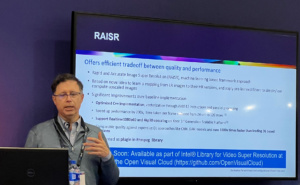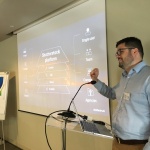Categories
Archives

The IPTC took part in a panel on Diversity and Inclusion at the CEPIC Congress 2022, the picture industry’s annual get-together, held this year in Mallorca Spain.
Google’s Anna Dickson hosted the panel, which also included Debbie Grossman of Adobe Stock, Christina Vaughan of ImageSource and Cultura, and photographer Ayo Banton.
Unfortunately Abhi Chaudhuri of Google couldn’t attend due to Covid, but Anna presented his material on Google’s new work surfacing skin tone in Google image search results.
Brendan Quinn, IPTC Managing Director participated on behalf of the IPTC Photo Metadata Working Group, who put together the Photo Metadata Standard including the new properties covering accessibility for visually impaired people: Alt Text (Accessibility) and Extended Description (Accessibility).
Brendan also discussed IPTC’s other Photo Metadata properties concerning diversity, including the Additional Model Information which can include material on “ethnicity and other facets of the model(s) in a model-released image”, and the characteristics sub-property of the Person Shown in the Image with Details property which can be used to enter “a property or trait of the person by selecting a term from a Controlled Vocabulary.”
Some interesting conversations ensued around the difficulty of keeping diversity information up to date in an ever-changing world of diversity language, the pros and cons of using controlled vocabularies (pre-selected word lists) to cover diversity information, and the differences in covering identity and diversity information on a self-reported basis versus reporting by the photographer, photo agency or customer.
It’s a fascinating area and we hope to be able to support the photographic industry’s push forward with concrete work that can be implemented at all types of photographic organisations to make the benefits of photography accessible for as many people as possible, regardless of their cultural, racial, sexual or disability identity.

Where else can you hear about the difficulties of examining photo metadata in NFTs, see a lifelike image of a human being generated from pure data before your eyes, see how Wikidata can be used to take semantic fingerprints of news articles, and discover that an hour is nowhere near long enough to discuss simplifying machine-readable rights? Nowhere but the IPTC Meeting, of course! And this year’s Spring Meeting was the venue for all of this and much more.
We held the meeting virtually from Monday May 16 to Wednesday May 18th, and attending were over 70 people from at least 45 organisations across more than 20 countries.
Along with our usual Working Group updates and committee meetings, we invited speakers from several fascinating startups, services and projects at member companies. Here’s a quick summary of their sessions:
- We heard from Kairntech who are working on a classification system based on extracting entities from news stories and building a “semantic fingerprint” which can be used for cross-language classification, search and content enhancement
- The New York Times’ R&D Lab presented PaperTrail, a project to enhance the quality of the Times’ print archive through the use of machine learning to improve on basic OCR techniques (they’re looking for collaborators, more info coming soon!)
- Bria.ai showed us how an API can be used to enhance and create images and videos through the use of a custom GAN model trained in a “responsible AI” method
- Margaret Warren talked us through her efforts in creating and selling an NFT, looking at the process view the perspective of a photo metadata expert
- Consultant and author Henrik de Gyor talked us through the latest in synthetic media, which will be helpful in helping us to finalise our Digital Source Type vocabulary for synthetic media
- Laurent Le Meur from EDRLab presented his project’s recommendation on a Text and Data Mining Reservation Protocol, which can be used by publishers to restrict the rights of data miners in scraping any content for the purpose of analysis or building a model
- We heard from Dominic Young of Axate on his approach to offer pay-as-you-go payment options on paywalled news sites based on a simple pre-paid wallet mechanism.
We also had many announcements and discussions around IPTC standards, many of which we will be revealing in the coming months. One notable update is that the Standards Committee approved ninjs version 1.4 which we will release soon.
Thanks to all the IPTC members, Working Group leads, committee members and guests who made this member meeting one to remember.

The National Association of Broadcasters (NAB) Show wrapped up its first face-to-face event in three years last week in Las Vegas. In spite of the name, this is an internationally attended trade conference and exhibition showcasing equipment, software and services for film and video production, management and distribution. There were 52,000 attendees, down from a typical 90-100k, with some reduction in booth density; overall the show was reminiscent of pre-COVID days. A few members of IPTC met while there: Mark Milstein (vAIsual), Alison Sullivan (MGM Resorts), Phil Avner (Associated Press) and Pam Fisher (The Media Institute). Kudos to Phil for working, showcasing ENPS on the AP stand, while others walked the exhibition stands.
NAB is a long-running event and several large vendors have large ‘anchor’ booths. Some such as Panasonic and Adobe reduced their normal NAB booth size, while Blackmagic had their normal ‘city block’-sized presence, teeming with traffic. In some ways the reduced booth density was ideal for visitors: plenty of tables and chairs populated the open areas making more meeting and refreshment space available. The NAB exhibition is substantially more widely attended than the conference, and this year several theatres were provided on the show floor for sessions any ‘exhibits only’ attendee could watch. Some content is now available here: https://nabshow.com/2022/videos-on-demand/
For the most part this was a show of ‘consolidation’ rather than ‘innovation’. For example, exhibitors were enjoying welcoming their partners and customers face-to-face rather than launching significant new products. Codecs standardised during the past several years were finally reaching mainstream support, with AV1, VP9 and HEVC well-represented across vendors. SVT-AV1 (Scalable Vector Technology) was particularly prevalent, having been well optimised and made available to use license-free by the standard’s contributors. VVC (Versatile Video Coding), a more recent and more advanced standard, is still too computationally intensive for commercial use, though a small set made mention of it on their stands (e.g. Fraunhofer).
IP is now fairly ubiquitous within broadcast ecosystems. To consolidate further, an IP Showcase booth illustrating support across standards bodies and professional organisations championed more sophisticated adoption. A pyramid graphic showing a cascade of ‘widely available’ to ‘rarely available’ sub-systems encouraged deeper adoption.
Super Resolution – raising the game for video upscaling
One of the show floor sessions – “Improving Video Quality with AI” – presented advances by iSIZE and Intel. The Intel technology may be particularly interesting to IPTC members, and concerns “Super Resolution.” Having followed the subject for over 20 years, for me this was a personal highlight of the show.
Super Resolution is a technique for creating higher resolution content from smaller originals. For example, achieving a professional quality 1080p video from a 480p source, or scaling up a social media-sized image for feature use.

A few years ago a novel and highly effective new Super Resolution method was innovated (“RAISR”, see https://arxiv.org/abs/1606.01299); this represented a major discontinuity in the field, albeit with the usual mountain of investment and work needed to take the ‘R’ (research) to ‘D’ (development).
This is exactly what Intel have done, and the resulting toolsets will be made available at no cost at the company’s Open Visual Cloud repository at the end of May.
Intel invested four years in improving the AI/ML algorithms (having created a massive ground truth library for learning), optimising to CPUs for performance and parallelisation, and then engineering the ‘applied’ tools developers need for integration (e.g. Docker containers, FFmpeg and GStreamer plug-ins). Performance will now be commercially robust.
The visual results are astonishing, and could have a major impact on the commercial potential of photographic and film/video collections needing to reach much higher resolutions or even to repair ‘blurriness’.
Next year’s event is the centennial of the first NAB Show and takes place from April 15th-19th in Las Vegas.
– Pam Fisher – Lead, IPTC Video Metadata Working Group

With less than two weeks to go, we are pleased to announce the full agenda for the IPTC Spring Meeting 2022.
The IPTC Spring Meeting 2022 will be held virtually from Monday May 16th to Wednesday May 18th, from 1300 – 1800 UTC each day.
IPTC member representatives can view the full agenda and register at https://iptc.org/moz/events/spring-meeting-2022/
Highlights of the meeting include:
- Updates from all IPTC Working Groups, including Photo Metadata, Video Metadata, NewsCodes, Sports Content, NewsML-G2 and News in JSON
- Updates from the IPTC PR Committee and the IPTC Standards Committee, including votes on proposed new versions of IPTC standards
- Invited presentations from:
- United Robots, presenting their “robot journalism” system built for media companies
- Axate‘s micropayments system for publishers
- Kairntech presenting their content classification system used by Agence France-Presse among others
- Bria.ai‘s image generation and manipulation API backed with cutting-edge artificial intelligence
- Consultant Henrik de Gyor speaking on the latest developments in synthetic media
- Laurent Le Meur from EDRLab discussing the W3C Text and Data Mining Community Group’s recommendation for a Text and Data Mining Reservation Protocol
- Member presentations:
- Recently-joined IPTC members will have a chance to introduce themselves and their organisations to the IPTC membership
- The New York Times presenting their “Papertrail” system used to target advertising based on content metadata
- Margaret Warren from ImageSnippets discussing what she learned when creating NFTs from her artwork
- Member discussions:
- IPTC members will be discussing how we might be able to simplify rights management with a cut-down basic set of rights assertions, possibly creating a simpler alternative to RightsML
- IPTC members will also be discussing the News Architecture and how we can better utilise the key data model that underlies both NewsML-G2 and ninjs
- and more!
Attendance to the 2022 IPTC Spring Meeting is free for all delegates and member experts from IPTC member organisations.
Invited speakers are welcome to attend the day on which they are speaking.